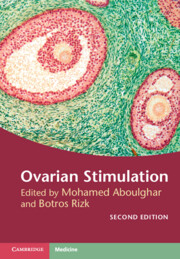Book contents
- Ovarian Stimulation
- Ovarian Stimulation
- Copyright page
- Dedication
- Contents
- Contributors
- About the Editors
- Foreword
- Preface to the first edition
- Preface to the second edition
- Section 1 Mild Forms of Ovarian Stimulation
- Chapter 1 Oral Agents for Ovarian Stimulation
- Chapter 2 Ovulation Induction for Anovulatory Patients
- Chapter 3 Ovarian Hyperstimulation in Combination with Intrauterine Insemination
- Chapter 4 Mild Approaches in Ovarian Stimulation
- Chapter 5 The Case against Mild Stimulation Protocols
- Section 2 Ovarian Hyperstimulation for IVF
- Section 3 Difficulties and Complications of Ovarian Stimulation and Implantation
- Section 4 Non-conventional Forms Used during Ovarian Stimulation
- Section 5 Alternatives to Ovarian Hyperstimulation and Delayed Transfer
- Section 6 Procedures before, during, and after Ovarian Stimulation
- Index
- References
Chapter 5 - The Case against Mild Stimulation Protocols
from Section 1 - Mild Forms of Ovarian Stimulation
Published online by Cambridge University Press: 14 April 2022
- Ovarian Stimulation
- Ovarian Stimulation
- Copyright page
- Dedication
- Contents
- Contributors
- About the Editors
- Foreword
- Preface to the first edition
- Preface to the second edition
- Section 1 Mild Forms of Ovarian Stimulation
- Chapter 1 Oral Agents for Ovarian Stimulation
- Chapter 2 Ovulation Induction for Anovulatory Patients
- Chapter 3 Ovarian Hyperstimulation in Combination with Intrauterine Insemination
- Chapter 4 Mild Approaches in Ovarian Stimulation
- Chapter 5 The Case against Mild Stimulation Protocols
- Section 2 Ovarian Hyperstimulation for IVF
- Section 3 Difficulties and Complications of Ovarian Stimulation and Implantation
- Section 4 Non-conventional Forms Used during Ovarian Stimulation
- Section 5 Alternatives to Ovarian Hyperstimulation and Delayed Transfer
- Section 6 Procedures before, during, and after Ovarian Stimulation
- Index
- References
Summary
The number of retrieved oocytes is one of the major parameters by which the intensity of ovarian stimulation is estimated. While conventional stimulation protocols in in vitro fertilization (IVF) are designed to obtain maximum oocytes yields, they have often been associated with increased risk of complications, increased costs derived from higher gonadotropin dosage, and lower embryo quality. For these reasons, physicians have introduced a milder approach to ovarian stimulation, focusing on a more patient-friendly and safe method, while attempting to improve IVF outcomes. Typically, the strengths of mild stimulation include: reduced mean number of days of stimulation, smaller total amount of gonadotropins, smaller mean number of oocytes retrieved balanced by possibly better embryo quality, decreased treatment discomfort, and reduced risk of complications. However, to date there are still unanswered questions about the possibility that a milder approach to ovarian stimulation is clinically superior to conventional regimens.
- Type
- Chapter
- Information
- Ovarian Stimulation , pp. 47 - 54Publisher: Cambridge University PressPrint publication year: 2022



